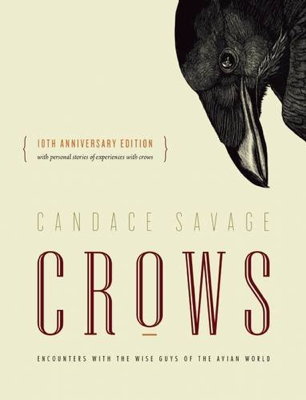Thu 9 Jun 2016
Review: Crows: Encounters with the Wise Guys of the Avian World by Candace Savage
Posted by PJ under books, crows, folklore, myth, review, science
No Comments

I love crows. Yes, I know. Crows are a hard sell to many people, but I am unrepentant. I’m fascinated by their intelligence, their creativity, and that look of presence when their eyes meet yours. So I was eager to read this book.
It surprised me when it arrived: a thin volume, only 113 pages including the index, but unusually weighty because it’s lavishly illustrated (every other page) on high-quality, heavy paper and beautifully put together. It takes great advantage of the space between the covers, cramming in so much information that the weightiness of the book seemed as much from the information as the heavy paper. Using it, I was able to verify that, yes, that exceptionally large dominant crow hanging around my house was indeed a crow and not a raven; and I was able to pick out the adolescent packs and understand their behavior better. Also what some of those screaming matches were about.
Their intelligence and resourcefulness make it easy to understand why crows have become such an integral part of so many mythologies, so much folklore. Their association with the trickster mythology is so ancient that it is shared in both Australian Aboriginal mythology and Native American. Considering how long these populations must have been isolated from each other and from the rest of the world, that’s rather impressive. There are trickster associations in European mythology as well.
But they aren’t just viewed as tricksters and evil omens. In some Buddhist traditions, they are regarded as protectors of the Dharma—cosmic law and order, among other things. In Hinduism, they are considered to be embodiments of the recently deceased, and to be messengers and information-givers. This echoes the Norse idea of Huginn and Muninn, the ravens who constantly brought information to Odin. And in some American Indian tribes, crows are considered not only tricksters, but creators of the world.
Ms. Savage covers various mythologies concerning crows, the latest scientific research, as well as keen observations of crow behavior throughout the ages. I guarantee you’ll have a different appreciation of these wise guys once you’ve read this book. I thoroughly enjoyed it.
Did you know—?
Crows are the only non-primates who make tools. Other critters use what they find around them as the occasional tool, but crows will actually take what they find and reshape it to accomplish tasks. They have complex social organizations and their own languages (topping 64,000 different calls). They love, they hate, they grieve, they practice deceit as well as bravery, they reason, are tender and harsh. They hit all the standards we declare are solely-human characteristics. They’re not only as amazing as I always suspected—they’re more amazing.
An excerpt:
[Avian researcher Carolee Caffrey] was observing a nest through a spotting scope when the breeding pair returned to feed their nestlings, only to discover that their nest had been raided by a raptor in their absence. “In all my life, I’ve never heard such horrible, bloodcurdling screams as the crows made at that nest. The male flew away after a minute or two, but the female stayed behind and, for the next four hours (until Caffrey reluctantly left), tended a surviving but injured nestling by nuzzling it, picking up its neck, and preening the side of its head. All the while, the crow uttered mournful-sounding oohs.
Another, more lighthearted one:
Scientists wanted to test the reasoning ability of some captive crows so they devised a complex series of boxes, some of which had bait inside, many that were empty.
[The crow named] Hugin figured out the rule on the first morning of the trials…His companion Munin, by contrast, couldn’t even be bothered to look. Instead, as the dominant bird in a group, he preferred to bide his time until Hugin found the food; then he would muscle in and gobble up one or more of the tasty tidbits….Socially subordinate though he was, Hugin was no pushover. On the first afternoon of the experiment, he came up with a countermove. When Munin began to press in on him, Hugin would interrupt his foraging, fly over to one of the unrewarded clusters, and start opening empty boxes. He kept at it, opening and opening, until Munin came to join him; then, as soon as he saw his rival nosing around the wrong cluster, Hugin would dash back to the rewarded boxes and take advantage of his head start to grab a few extra morsels.
No Responses to “ Review: Crows: Encounters with the Wise Guys of the Avian World by Candace Savage ”